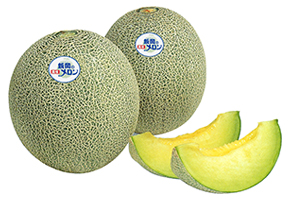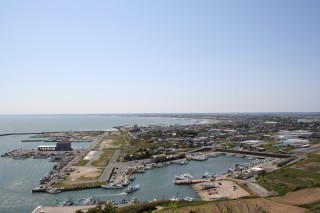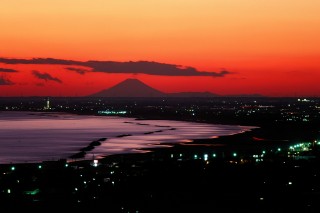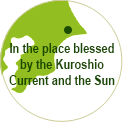Summary and Characteristics of Takami (貴味) melon
Takami Melon is put out by Japan Horticultural Production and Research Institute in 1990. It’s a greenhouse melon with green-meat and netting, whose skin is dark green. It has a rich aroma and a high sugar content. It’s a hybrid of (Amusu Melon×Delicy) and (Taiwanese F1hybrid fixed-type melon for a trial). A famous cultivar which was growned by the institute is used as a material of one parent. As a material of the other parent, F1hybrid of honeydew melon, which was improved in Taiwan is used. Takami Melon received high storability from honeydew melons and keeps the quality and deliciousness for a long time (for 7days and longer from the 5th day after the harvest).
Amusu Melon
n achieving a big success. That got much attention and 13 farmers in Iioka started to cultivate Amus Melon in1979. Because the cultivation skill was poor at first, they formed good connection with related organizations, made effort to improve the quality year by year and the planting increased. Amusu Melon turned to be a main product instead of watermelon, which was a main product originally. The cultivating ways of it are greenhouse farming and tunnel farming. As above the cultivation of Amusu Melon is started by 13 farmers and the next year they started to ship together as the Melon Section of the Horticultural Department of Iioka town Agricultural Cooperatives. After that the cultivation of Amusu Melon expanded all over Iioka town because the planting area was increased. In 1984, roller conveyors were introduced to save much time of producers, and in 1985, by employing part-time workers, the shipping work by the producers got to be much easier than before. Besides that, inspection by part-time workers has performed since 1988 and that helps producers to ship melons which are equalized shape and of stable quality those matches with consumer’s needs. The main shipping destinations are Kanto region and Tohoku region.
What’s Iioka Takami Melon?
Although melon has various varieties, Takami Melon is especially sweet and it has approx.16 brix degree in sugar content. It has high sugar content but the taste is light and refreshing. Iioka area of Asahi city is the first producing area in Japan and we sell Takami Melon with the catch phrase “noble taste, Iioka Takami Melon”. Iioka Takami Melon is raised by skillful producers with their hearts, taking much time and labor, and has gained a good reputation among customers and markets.

| Producing area | Asahi city, Chiba prefecture |
|---|---|
| Organization | JA Chibamidori Iioka Melon Department |
| Products | Takami Melon, Orphe Melon |
| Shipping Term | June, July |
| Shipping Amount | 380,000cases (packed in cardboard boxes, 3kg/ 5kg) |
| Growing | 65ha |
| The Number of Producers | 91 |
*as of 1 June, 2014
Introduction of Producing Area
Iioka area of Asahi city is located at the east end of Kujukuri Beach. The Gyobu Cape Lighthouse commands a whole view of the town. Iioka Melon grows into a delicious and tasteful fruit because the climate, which is calm and is cool in summer, is suitable for cultivation of melons. This area is the first producing area of Takami Melon in Japan. As for shipping, we harvest looking at each “face” of melons in many fields and ship after selected carefully. The main shipping destinations are Kanto region and Tohoku region.
Location of Chiba Prefecture
Chiba Prefecture is crisscrossed by rivers, surrounded by the sea and blessed with rich natural resources, including the water and forests. It is located on the eastern side of the Tokyo metropolitan area, and occupies a peninsula that juts out into the Pacific Ocean. The southeastern part of the peninsula faces the Pacific Ocean, while the western side faces Tokyo Bay. Chiba Prefecture adjoins the Tokyo Metropolis and Saitama Prefecture to the northwest, and Ibaraki Prefecture to the north.
Profile of Asahi City
Asahi city is located in the north eastern part of Chiba prefecture, approximately 50 kilometers from Chiba city and 80 kilometers from the Tokyo metropolitan area. The southern part of Asahi faces towards Kujyukuri beach, which is beautifully bow shaped. The northern part faces towards Higata-hachi-man-goku, with mild hilly terrain, where granaries and rice paddies are abundant. Asahi Central City has a main road (route 126) passing through from east to west, and the JR Sobu line passes through as well. The Central city is the most densely populated. The average yearly temperature in Asahi city is 15 degree Centigrade, making it a mild and warm climate.
The city is well balanced between fishery, commerce, and various industries, such as forestry nurseries, flowers grown for commercial florists and market gardening. Asahi city also boasts considerable agriculture, with rice and grain production, poultry and beef.
Since the first of July, 2005, Asahi City, Unakami-machi, Iioka-machi and Hikata-machi were merged into one city, Asahi City. The new designated city area was set at 129.91 square kilometres, and the population of Asahi City after the merge is approximately 71,000. Asahi City is a core population center of the Toso region and the general expectation is for steady growth.
Location
Longitude 140degrees and 39' Latitude 35degrees and 43'2"
Altitude
Less than 68.4m above sea level (near Iioka Gyobu Cape)
The origin of the name "Asahi"
After the end of the Muro-machi Shogunate (late 16th century), General Yoshimasa Kiso (he was the 19th descendant of Yoshinaka Kiso), the Governor of the Toso area, concentrated his efforts on being a good politician. He gained a good reputation because of his efforts, and was very popular. In 1852, a poet from Kyoto named Takamasa Nonoguchi visited this region and wrote a flattering poem describing General Kiso. From this poem, the name Asahi was derived. "from Shinano (currently the Prefecture of Nagano) / adoring the rising sun / he came to the eastern land / and there remains the evidence of his earthly life"


Outline of Asahi City
- Distance to Tokyo Disney Resort: approx. 95km
- Distance to Narita International Airport: approx. 35km
- Distance to Shisui Premium Outlets: approx. 45km
- Distance from Fukushima Daiichi Nuclear Power Station: approx. 275km


